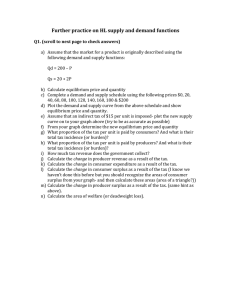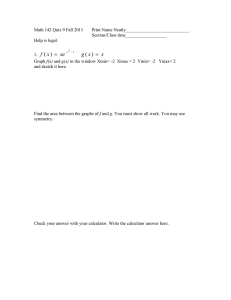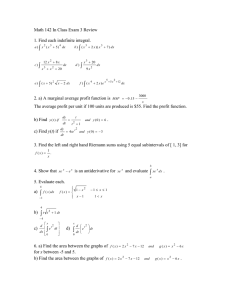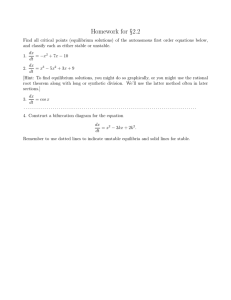Qualifying Examination: Microeconomics 29 July 2013 General Instructions
advertisement
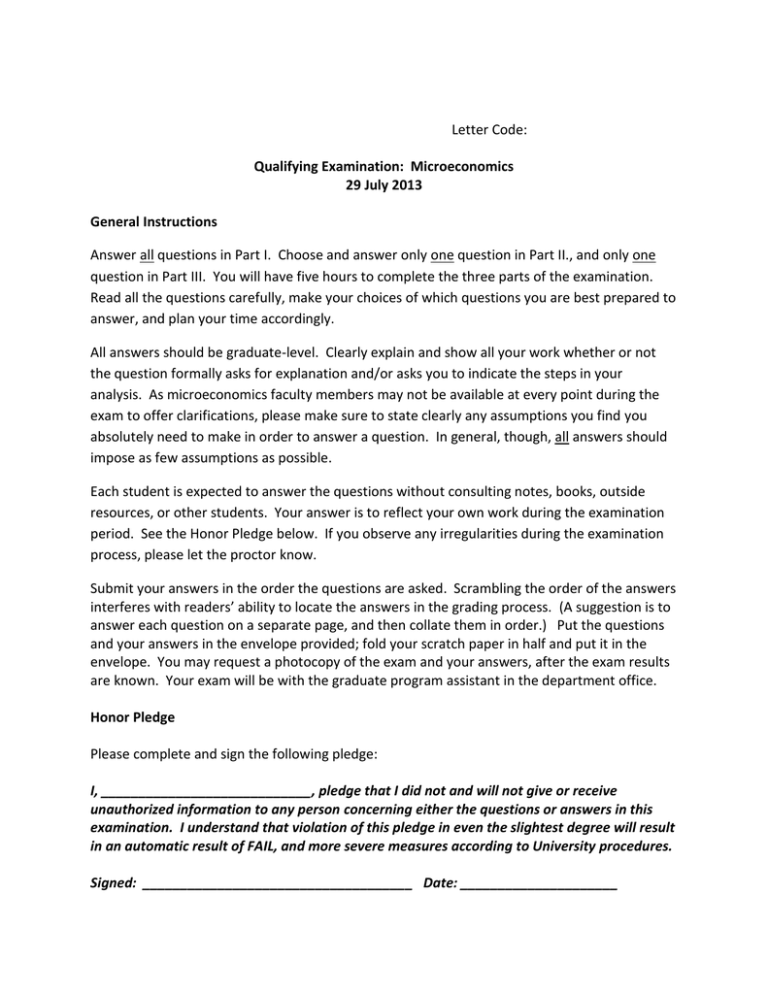
Letter Code: Qualifying Examination: Microeconomics 29 July 2013 General Instructions Answer all questions in Part I. Choose and answer only one question in Part II., and only one question in Part III. You will have five hours to complete the three parts of the examination. Read all the questions carefully, make your choices of which questions you are best prepared to answer, and plan your time accordingly. All answers should be graduate-level. Clearly explain and show all your work whether or not the question formally asks for explanation and/or asks you to indicate the steps in your analysis. As microeconomics faculty members may not be available at every point during the exam to offer clarifications, please make sure to state clearly any assumptions you find you absolutely need to make in order to answer a question. In general, though, all answers should impose as few assumptions as possible. Each student is expected to answer the questions without consulting notes, books, outside resources, or other students. Your answer is to reflect your own work during the examination period. See the Honor Pledge below. If you observe any irregularities during the examination process, please let the proctor know. Submit your answers in the order the questions are asked. Scrambling the order of the answers interferes with readers’ ability to locate the answers in the grading process. (A suggestion is to answer each question on a separate page, and then collate them in order.) Put the questions and your answers in the envelope provided; fold your scratch paper in half and put it in the envelope. You may request a photocopy of the exam and your answers, after the exam results are known. Your exam will be with the graduate program assistant in the department office. Honor Pledge Please complete and sign the following pledge: I, ____________________________, pledge that I did not and will not give or receive unauthorized information to any person concerning either the questions or answers in this examination. I understand that violation of this pledge in even the slightest degree will result in an automatic result of FAIL, and more severe measures according to University procedures. Signed: ____________________________________ Date: _____________________ PART I. Respond to each of the nine statements in this part by stating whether it is TRUE, FALSE, or UNCERTAIN, and provide a justification for your answer. 1. If a person has the indirect utility function V = I2 / (p1p2), then the Hicksian demand function for good 1 will be h1 = (p2/p1)1/2 (U1/2/2). 2. In the case of a price increase for an inferior good, the compensating variation (cv) measure of welfare change will always be larger than the equivalent variation (ev) measure. 3. In a 2-good world, a person with a Von Neumann-Morganstern utility function U = x12 x2 would be said to be risk loving. 4. For a 1-input, 2-output producer whose technology constraint is y12 + y2 – y3 ≤ 0, the technology set in R3 space is convex and divisible. 5. A firm’s cost function C(w,y) must be homogeneous of degree 1 in w (the vector of input prices). 6. Consider a game in which a particular player has N information sets, indexed by n=1,2,… Suppose that he has Mn possible actions at information set n. The player therefore has ∑ strategies in all. 7. In the game below, the only PBE (and sequentially equilibrium) involves mixing in the continuation game. 1 R L 2 4,5 A B [μ] l 0,1 1 r [1- μ] l 6,7 9,8 5,4 r 3,2 8. Imagine a 2-person, 2-commodity exchange economy. If both consumers consider the 2 goods to be perfect substitutes, then the contract curve always lies along one of the x- and one of the y-axes. 9. Suppose student/workers are of two types, L and H, and that there are at least two potential employers. The incremental profits earned from hiring a worker of type i is πi, with πH > πL. Events unfold as follows: (1) Students observe their types (employers do not). (2) Students choose education, e, which is costly and observed by employers, but is not productive. (3) Employers name wages for prospective workers (currently students), w, contingent on observed education (Bertrand competition). (4) Students choose employers and become workers. The utility for a student/worker of type i receiving a wage w is given by U(w,e) = w – ci(e). The payoff for the employer of a type i student/worker paying a wage w is given by πi – w. Assume: cH(e) = e2, and cL(e) = e. Suppose that, in addition to obtaining education, student/workers can also signal their type by spending summer vacations interning. Suppose that the amount of time spent interning (unpaid), t, is observable by employers. Apart from this time cost, student/workers are entirely indifferent about interning, and the cost of interning does not depend upon the student/worker’s type. Thus, the student/worker’s payoff is now given by w – ci(e) – t. Student/workers choose e and t simultaneously. For an arbitrary πH – πL > 0, complete separation of types in equilibrium using a combination of the signals e and t involves the H-type choosing e = ½. Part II Answer ONE of the following two questions 10. Consider a consumer in a 2-good world with income of I = 1000 and preferences represented by the utility function U = x1 + 50 ln x2. (a) What are this consumer’s demand functions for x1 and x2? Be sure to account for the possibility of corner solutions. (b) Derive the consumer’s income elasticities of demand for both goods. Would you describe each good as normal, inferior, necessity, luxury, other? Explain. (c) Suppose the market for x1 is made up of 3000 consumers identical to the one described above, and a large number of suppliers who can produce the good at a constant unit cost of 15. Describe the market equilibrium, in terms of price, quantity, consumer surplus (CS), and producer surplus. (d) What will happen to all those outcomes if the unit production cost rises to 25? What is the change in consumer surplus per person? (e) As an alternative to consumer surplus change, calculate the compensating variation in income (CV) for this price increase, for an individual. How does it compare to the change in consumer surplus? Interpret the difference. 11. Consider a monopolist who produces output y using a single input x, according to the production function y = 4x1/2, and who can sell the output in a market with aggregate demand function yd = 100 p-e. (a) Would this producer’s technology be described as “convex”? Explain. (b) Formulate the producer’s profit-maximization problem, and derive the maximizing solution. (c) Why is it necessary to have e > 1 for this producer to operate effectively? Relate your answer to the mathematics of the solution AND to the general intuitive interpretation of e. (d) What amount of consumer surplus, producer surplus, and total surplus is generated in this monopolized market? (e) What will happen to all the outcome values if a new entrant causes the market to change from monopoly to Cournot-style duopoly? Be specific with respect to the solution values in the new equilibrium. Part III Answer ONE of the following two questions 12. Two firms, 1 and 2, are the only suppliers of a completely homogeneous good. There is an infinite sequence of discrete periods. In each period, the firms compete by simultaneously naming prices, pi∈ℝ+. Consumers purchase the good from the firm naming the lowest price, and are indifferent between the firms if the prices are identical. (You can resolve consumer indifference however you like to sustain an equilibrium.) Total demand is equal to one (infinitely divisible) unit when price is less than or equal to some reservation level v, and equals zero if price exceeds v. The unit cost of production for firm i is ci, with c1 < c2; production is characterized by constant returns to scale. The choices in each period are observed by both firms prior to the next period, and the two firms share a constant discount factor, δ. For the following questions, focus exclusively on pure strategy subgame perfect equilibria with the following stationarity property: within any subgame, the same outcome occurs in every period on the equilibrium path. (a) (i) Show that there is an equilibrium that yields zero profits for both firms. (ii) Is there an equilibrium that yields lower payoffs to either firm? Why? (iii) Determine the set of sustainable prices (in equilibria as defined here) as a function of δ. (b) Consider the same problem, only now imagine that the two firms operate in two markets that are identical except that one firm is the low cost producer in one market, while the other is the low cost producer in the other market. Focus again on pure strategy subgame perfect equilibria with the stationarity property as above, but in this case further restrict attention to equilibria in which each market is served exclusively by the low cost producer, and where the price is the same in both markets. (i) Determine the set of sustainable prices (in equilibria as defined here) as a function of δ. (ii) Is it possible to sustain some price above c2 for all δ > 0? (iii) How does the highest sustainable price change as δ increases? 13. Consider an exchange economy with 2 agents and 2 commodities. Agents' utility functions are U1(c1,c2) = log(c1) + 3log(c2) and U2(c1,c2) = (c10.5 + c20.5)2. Agents' endowments are e1 = (1,4) and e2 = (4,1). (a) Define the contract curve in words. (b) Solve for the contract curve. (c) Define a competitive equilibrium for this economy. (d) Solve for each consumers’ demand curves as a function of prices. (e) Compute a competitive equilibrium for this economy. In the solution, normalize p1 = 1.


